There's always something about doing things outside the home that doing the same in the home can be no real substitute for. We can go and rent movies to play on our VCRs or DVDs, or we can watch them through pay-per-view or premium channels through our big-screen high-definition TVs, but the thrill of being in a big dark theatre room watching the latest run movie on a big screen with a high-quality sound system pumping out the volume makes the home experience pale in comparison. Of course, in addition to that, you have a whole audience who participates in the cheering, laughing, mourning, and razzing of whatever action takes place before their eyes -- not to the same level of interactivity as with something like The Rocky Horror Picture Show, mind you, but as far as doing so makes you part of the audience.
As with watching movies, eating your favorite foods, or even shopping, so it is also with playing videogames. As much as we like to sit at home in our comfortable seats with our favorite joysticks, loading up our computers and game consoles with our favorite videogames, the arcade experience is just something that needs to be visited like a holy site pilgrimage by any hard-core home gamer. Besides the games being visually bigger and louder and almost more immersive in its atmosphere than what the equivalent at home can provide, the arcades also provide the place for social interaction and competition among gamers who think they have what it takes to the best player there is in the place...or at least good enough to impress the next person standing around watching them play.
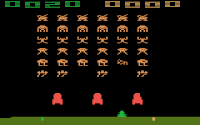 Yet from early on in videogame history, game makers realized that we need to have our own place to call our personal gaming heaven, our Fortress of Solitude, and that we cannot realistically spend all our living moments in the family amusement centers. Thus began the impetus to bring the arcade experience home, to make home versions of the games we play feel very much like the ones we wasted our pocket change on. Atari began this with the translation of various arcade games, both those of other companies and those of their own making, for the Atari 2600 Video Computer System, from the early classics such as Breakout and Night Driver to the latest like Millipede and Missile Command. With the powerful backing of its then-parent company Warner Communications, Atari could afford to obtain licenses to the latest and greatest in arcade titles, including Space Invaders, one of the first games apart from the free Combat pack-in cartridge that sold 2600 systems by the millions. Other companies that developed and supported game systems, like Mattel and Magnavox, who couldn't get their hands on the actual names of the games, either had to make do with their own translations bearing interesting alternate titles or, as in the case with the Intellivision, focused on obtaining licenses for things like sports games.
Yet from early on in videogame history, game makers realized that we need to have our own place to call our personal gaming heaven, our Fortress of Solitude, and that we cannot realistically spend all our living moments in the family amusement centers. Thus began the impetus to bring the arcade experience home, to make home versions of the games we play feel very much like the ones we wasted our pocket change on. Atari began this with the translation of various arcade games, both those of other companies and those of their own making, for the Atari 2600 Video Computer System, from the early classics such as Breakout and Night Driver to the latest like Millipede and Missile Command. With the powerful backing of its then-parent company Warner Communications, Atari could afford to obtain licenses to the latest and greatest in arcade titles, including Space Invaders, one of the first games apart from the free Combat pack-in cartridge that sold 2600 systems by the millions. Other companies that developed and supported game systems, like Mattel and Magnavox, who couldn't get their hands on the actual names of the games, either had to make do with their own translations bearing interesting alternate titles or, as in the case with the Intellivision, focused on obtaining licenses for things like sports games.
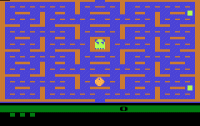 However, the Atari 2600 could only go so far in its reproducing arcade games, and game developers and players alike found that out when Pac-Man made its spectacular debut in the spring of 1982, only to find itself to be the best seller of a not-so-great translation job. Things only started getting worse as more and more arcade titles found their way into Atari 2600 cartridge casings, with the programmers responsible for doing the translations scrambling to deal with things such as the limited amount of system memory, the limited number of onscreen characters it could handle without causing it to flicker, or, as in the case of games like Defender and Mousetrap, the limited number of buttons on an Atari 2600 joystick controller. The unreleased prototype of Tempest for that system showed considerable strain, for it contained only one screen (which due to the quality of the 2600 graphics looked like a pair of striped underpants) and only one type of enemy for you to deal with, as opposed to the several different species in the original.
However, the Atari 2600 could only go so far in its reproducing arcade games, and game developers and players alike found that out when Pac-Man made its spectacular debut in the spring of 1982, only to find itself to be the best seller of a not-so-great translation job. Things only started getting worse as more and more arcade titles found their way into Atari 2600 cartridge casings, with the programmers responsible for doing the translations scrambling to deal with things such as the limited amount of system memory, the limited number of onscreen characters it could handle without causing it to flicker, or, as in the case of games like Defender and Mousetrap, the limited number of buttons on an Atari 2600 joystick controller. The unreleased prototype of Tempest for that system showed considerable strain, for it contained only one screen (which due to the quality of the 2600 graphics looked like a pair of striped underpants) and only one type of enemy for you to deal with, as opposed to the several different species in the original.
By late 1982, the Atari 2600 found itself replaced by the Atari 5200 Supersystem and the ColecoVision as the premium systems for playing quality arcade game titles on. GCE's tabletop Vectrex system, also released around that time, brought CinemaTronics' Star Castle and Rip Off to our living rooms and bedrooms with the same sharp line-drawn imagery that made their coin-op counterparts fun to play. The ColecoVision, in particular, held greater interest to gamers than the Atari 5200, partly due to the home release of its pack-in game, Nintendo's Donkey Kong, and to the subsequent adaptations of Zaxxon, Turbo, and Venture. The Atari 5200, while it featured a better version of Pac-Man, was in itself a modified version of their 400/800 line of personal computers saddled with a horrible and incompatible game controller that made playing such a game less than satisfying. Still, despite the unique failings of all three systems combined, they provided the closest graphical, audial, and stimulating approximation of the arcade until two coin-op companies, Sega and Nintendo, started developing their own home systems, further pushing the envelope of versimilitude with the releases of Super Mario Bros., Afterburner, and Altered Beast. SNK, with their Neo-Geo system, on the other hand, went about the translation problem a different way -- they made their games run on the same hardware that runs the coin-op version of the machine, though it also made the Neo-Geo and its games library very costly to own.
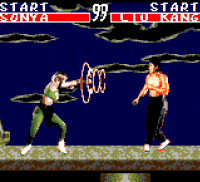 The year 1993, interestingly enough, became a benchmark when a multiple-system release of the arcade game Mortal Kombat became the first popular game when such a high-quality adaptation actually required a necessary deletion of an element that would come about in other games as necessary in terms of dealing with a system's technical limitations. Nintendo, wishing to keep the image of the Super NES and Gameboy systems as being "kid-friendly" and "family-friendly", had Acclaim, the company responsible for the translation, remove the blood spews from certain body blows and then modify half the finishing moves (called "fatalities" in the arcade original) in their versions of the game. The Genesis and Game Gear versions, conversely, kept these things intact, yet only accessible through entering a controller code upon turning on the game. This biased modification on the part of appeasing Nintendo had the effect of boosting sales for the Genesis and Game Gear versions, very much to where in the following year, they decided to leave such gruesome elements alone in the Super NES and Gameboy release of Mortal Kombat II and just have Acclaim put a warning label on the box the cartridge came in.
The year 1993, interestingly enough, became a benchmark when a multiple-system release of the arcade game Mortal Kombat became the first popular game when such a high-quality adaptation actually required a necessary deletion of an element that would come about in other games as necessary in terms of dealing with a system's technical limitations. Nintendo, wishing to keep the image of the Super NES and Gameboy systems as being "kid-friendly" and "family-friendly", had Acclaim, the company responsible for the translation, remove the blood spews from certain body blows and then modify half the finishing moves (called "fatalities" in the arcade original) in their versions of the game. The Genesis and Game Gear versions, conversely, kept these things intact, yet only accessible through entering a controller code upon turning on the game. This biased modification on the part of appeasing Nintendo had the effect of boosting sales for the Genesis and Game Gear versions, very much to where in the following year, they decided to leave such gruesome elements alone in the Super NES and Gameboy release of Mortal Kombat II and just have Acclaim put a warning label on the box the cartridge came in.
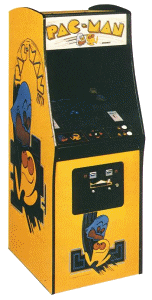 Nowadays, though, with personal computers and home units capable of matching almost anything that can be played in the arcade, there's another approach being taken to the art of such replication -- developing programs that emulate the very machines that the coin-op games run on, like M.A.M.E. and Callus and Raine for personal computers and even for the likes of X-Box and Playstation. This "reverse-engineering" way of thinking, which avoided the attempt of direct translation altogether, led to yet another level of replicating the arcade experience, which is to build or refurbish an existing machine, complete with a monitor, a control panel with actual arcade-quality controls, and even extra touches like light-up marquees and side art images, for housing the guts of a modified computer motherboard to run such programs on. Admittedly, this level of reproduction doesn't come cheap, as hobbyists who are into building their own arcade machines for home use can attest to. But the results can be interesting to behold, as websites such as Arcade At Home display such bold labors of love for gaming.
Nowadays, though, with personal computers and home units capable of matching almost anything that can be played in the arcade, there's another approach being taken to the art of such replication -- developing programs that emulate the very machines that the coin-op games run on, like M.A.M.E. and Callus and Raine for personal computers and even for the likes of X-Box and Playstation. This "reverse-engineering" way of thinking, which avoided the attempt of direct translation altogether, led to yet another level of replicating the arcade experience, which is to build or refurbish an existing machine, complete with a monitor, a control panel with actual arcade-quality controls, and even extra touches like light-up marquees and side art images, for housing the guts of a modified computer motherboard to run such programs on. Admittedly, this level of reproduction doesn't come cheap, as hobbyists who are into building their own arcade machines for home use can attest to. But the results can be interesting to behold, as websites such as Arcade At Home display such bold labors of love for gaming.
Then again, it doesn't hurt to get out every once in a while to try beating somebody or making a fool of yourself in your local arcade!
 Yet from early on in videogame history, game makers realized that we need to have our own place to call our personal gaming heaven, our Fortress of Solitude, and that we cannot realistically spend all our living moments in the family amusement centers. Thus began the impetus to bring the arcade experience home, to make home versions of the games we play feel very much like the ones we wasted our pocket change on. Atari began this with the translation of various arcade games, both those of other companies and those of their own making, for the Atari 2600 Video Computer System, from the early classics such as Breakout and Night Driver to the latest like Millipede and Missile Command. With the powerful backing of its then-parent company Warner Communications, Atari could afford to obtain licenses to the latest and greatest in arcade titles, including Space Invaders, one of the first games apart from the free Combat pack-in cartridge that sold 2600 systems by the millions. Other companies that developed and supported game systems, like Mattel and Magnavox, who couldn't get their hands on the actual names of the games, either had to make do with their own translations bearing interesting alternate titles or, as in the case with the Intellivision, focused on obtaining licenses for things like sports games.
Yet from early on in videogame history, game makers realized that we need to have our own place to call our personal gaming heaven, our Fortress of Solitude, and that we cannot realistically spend all our living moments in the family amusement centers. Thus began the impetus to bring the arcade experience home, to make home versions of the games we play feel very much like the ones we wasted our pocket change on. Atari began this with the translation of various arcade games, both those of other companies and those of their own making, for the Atari 2600 Video Computer System, from the early classics such as Breakout and Night Driver to the latest like Millipede and Missile Command. With the powerful backing of its then-parent company Warner Communications, Atari could afford to obtain licenses to the latest and greatest in arcade titles, including Space Invaders, one of the first games apart from the free Combat pack-in cartridge that sold 2600 systems by the millions. Other companies that developed and supported game systems, like Mattel and Magnavox, who couldn't get their hands on the actual names of the games, either had to make do with their own translations bearing interesting alternate titles or, as in the case with the Intellivision, focused on obtaining licenses for things like sports games. However, the Atari 2600 could only go so far in its reproducing arcade games, and game developers and players alike found that out when Pac-Man made its spectacular debut in the spring of 1982, only to find itself to be the best seller of a not-so-great translation job. Things only started getting worse as more and more arcade titles found their way into Atari 2600 cartridge casings, with the programmers responsible for doing the translations scrambling to deal with things such as the limited amount of system memory, the limited number of onscreen characters it could handle without causing it to flicker, or, as in the case of games like Defender and Mousetrap, the limited number of buttons on an Atari 2600 joystick controller. The unreleased prototype of Tempest for that system showed considerable strain, for it contained only one screen (which due to the quality of the 2600 graphics looked like a pair of striped underpants) and only one type of enemy for you to deal with, as opposed to the several different species in the original.
However, the Atari 2600 could only go so far in its reproducing arcade games, and game developers and players alike found that out when Pac-Man made its spectacular debut in the spring of 1982, only to find itself to be the best seller of a not-so-great translation job. Things only started getting worse as more and more arcade titles found their way into Atari 2600 cartridge casings, with the programmers responsible for doing the translations scrambling to deal with things such as the limited amount of system memory, the limited number of onscreen characters it could handle without causing it to flicker, or, as in the case of games like Defender and Mousetrap, the limited number of buttons on an Atari 2600 joystick controller. The unreleased prototype of Tempest for that system showed considerable strain, for it contained only one screen (which due to the quality of the 2600 graphics looked like a pair of striped underpants) and only one type of enemy for you to deal with, as opposed to the several different species in the original.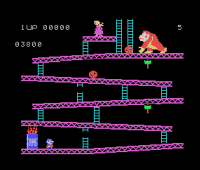
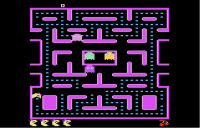
 The year 1993, interestingly enough, became a benchmark when a multiple-system release of the arcade game Mortal Kombat became the first popular game when such a high-quality adaptation actually required a necessary deletion of an element that would come about in other games as necessary in terms of dealing with a system's technical limitations. Nintendo, wishing to keep the image of the Super NES and Gameboy systems as being "kid-friendly" and "family-friendly", had Acclaim, the company responsible for the translation, remove the blood spews from certain body blows and then modify half the finishing moves (called "fatalities" in the arcade original) in their versions of the game. The Genesis and Game Gear versions, conversely, kept these things intact, yet only accessible through entering a controller code upon turning on the game. This biased modification on the part of appeasing Nintendo had the effect of boosting sales for the Genesis and Game Gear versions, very much to where in the following year, they decided to leave such gruesome elements alone in the Super NES and Gameboy release of Mortal Kombat II and just have Acclaim put a warning label on the box the cartridge came in.
The year 1993, interestingly enough, became a benchmark when a multiple-system release of the arcade game Mortal Kombat became the first popular game when such a high-quality adaptation actually required a necessary deletion of an element that would come about in other games as necessary in terms of dealing with a system's technical limitations. Nintendo, wishing to keep the image of the Super NES and Gameboy systems as being "kid-friendly" and "family-friendly", had Acclaim, the company responsible for the translation, remove the blood spews from certain body blows and then modify half the finishing moves (called "fatalities" in the arcade original) in their versions of the game. The Genesis and Game Gear versions, conversely, kept these things intact, yet only accessible through entering a controller code upon turning on the game. This biased modification on the part of appeasing Nintendo had the effect of boosting sales for the Genesis and Game Gear versions, very much to where in the following year, they decided to leave such gruesome elements alone in the Super NES and Gameboy release of Mortal Kombat II and just have Acclaim put a warning label on the box the cartridge came in. Nowadays, though, with personal computers and home units capable of matching almost anything that can be played in the arcade, there's another approach being taken to the art of such replication -- developing programs that emulate the very machines that the coin-op games run on, like M.A.M.E. and Callus and Raine for personal computers and even for the likes of X-Box and Playstation. This "reverse-engineering" way of thinking, which avoided the attempt of direct translation altogether, led to yet another level of replicating the arcade experience, which is to build or refurbish an existing machine, complete with a monitor, a control panel with actual arcade-quality controls, and even extra touches like light-up marquees and side art images, for housing the guts of a modified computer motherboard to run such programs on. Admittedly, this level of reproduction doesn't come cheap, as hobbyists who are into building their own arcade machines for home use can attest to. But the results can be interesting to behold, as websites such as
Nowadays, though, with personal computers and home units capable of matching almost anything that can be played in the arcade, there's another approach being taken to the art of such replication -- developing programs that emulate the very machines that the coin-op games run on, like M.A.M.E. and Callus and Raine for personal computers and even for the likes of X-Box and Playstation. This "reverse-engineering" way of thinking, which avoided the attempt of direct translation altogether, led to yet another level of replicating the arcade experience, which is to build or refurbish an existing machine, complete with a monitor, a control panel with actual arcade-quality controls, and even extra touches like light-up marquees and side art images, for housing the guts of a modified computer motherboard to run such programs on. Admittedly, this level of reproduction doesn't come cheap, as hobbyists who are into building their own arcade machines for home use can attest to. But the results can be interesting to behold, as websites such as 